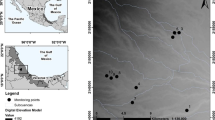Abstract
The ontogenetic spectra and age structure of cenopopulations of key species, Pinus sibirica (DuTour) and Abies sibirica (Ledeb.), have been studied in a climax Siberian pine forest with Carex macroura, tall herbs, and ferns (the most common forest type among chern forests of the Western Sayan). The rates of ontogenetic development of P. sibirica and A. sibirica cenopopulations under given site conditions have been estimated. These cenopopulations differ in structure but are stable. The mechanism of their stability is described, which is provided by a complex interaction of forest-forming tree species under competition from highly developed herbaceous layer.
Similar content being viewed by others
References
Tipy lesovgor Yuzhnoi Sibiri (Forest Types in the Mountains of Southern Siberia), Novosibirsk: Nauka, 1980.
Polikarpov, N.P., Chebakova, N.M., and Nazimova, D.I., Klimat i gornye lesa Yuzhnoi Sibiri (The Climate and Mountain Forests of Southern Siberia), Novosibirsk: Nauka, 1986.
Nazimova, D.I., Danilina, D.M., and Stepanov, N.V., Rain-barrier forest ecosystems of the Sayan Mountains, Botanica Pacifica, 2014, vol. 3, no. 1, pp. 39–47. https://doi.org/10.15372/SJFS20150401
Stepanov, N.V., Vascular plants in the Yenisei Sayan Mountains, Doctoral (Biol.) Dissertation, Krasnoyarsk, 2014.
Kedrovye lesa Sibiri (Siberian Stone Pine Forest of Siberia), Semechkin, I.V., Polikarpov, N.P., Irosh-nikov, A.I., Eds., Novosibirsk: Nauka, 1985.
Polikarpov, N.P., Integrated research in mountain forests of the Western Sayan, in Voprosy lesovedeniya (Problems in Forest Science), vol. 1, Krasnoyarsk, 1970, pp. 26–79.
Sukachev, V.N., Some general problems in theoretical phytocenology, in Voprosy botaniki (Problems in Botany), Moscow, 1954, pp. 290–300.
Sukachev, V.N. and Zonn, S.V., Metodicheskie ukaza-niya k izucheniyu tipov lesa (Methodological Guidelines for Studies on Forest Types), Moscow: Akad. Nauk SSSR, 1961.
Cherepanov, S.K., Sosudistye rasteniya Rossii i sopre-del’nykh gosudarstv (v predelakh byvshego SSSR) (Vascular Plants of Russia and Neighboring Countries within the Borders of the Former Soviet Union), St. Petersburg, 1995.
Polyakov, V.I. and Semechkin, I.V., Dynamics and stability of Siberian pine chern forests of the Western Sayan, Lesovedenie, 2004, no. 4, pp. 1–14.
Polyakov, V.I., Chernevye kedrovniki Zapadnogo Say-ana: kontrol’ i prognozirovanie khoda rosta (Siberian Pine Chern Forests of the Western Sayan: Monitoring and Growth Forecast), Novosibirsk: Sib. Otd. Ross. Akad. Nauk, 2007.
Nikolaeva, S.A., Velisevich, S.N., and Savchuk, D.A., Ontogeny of Siberian stone pine in the Ket’—Chulym interfluve, Vestn. Tomsk. Gos. Univ., Ser. Biol., 2008, no. 3 (4), pp. 24–34.
Makhatkov, I.D., Multiversality of Siberian fir ontogeny, Bull. Mosk. O-va Ispyt. Prir., Otd. Biol., 1991, vol. 96, no. 4, pp. 79–88.
Vostochnoevropeiskie lesa: istoriya v golotsene i sovremen-nost’ (Forests of Eastern Europe: Holocene History and Current State), Moscow: Nauka, 2004.
Stavrova, N.I., The structure of woody plant populations at different stages of progressive succession in forests of northern European Russia, in Aktual’nye problemy geobotaniki: III Vserossiiskaya shkola-konferentsiya (Current Problems in Geobotany: III All-Russia Conf.), Petrozavodsk, 2007, pp. 397–407.
Dyrenkov, S.A., Struktura i dinamika taezhnykh el’nikov (The Structure and Dynamics of Taiga Spruce Forests), Leningrad: Nauka, 1984.
Semechkin, I.V., Struktura i dinamika kedrovnikov Sibiri (The Structure and Dynamics of Siberian Stone Pine Forests in Siberia), Novosibirsk: Sib. Otd. Ross. Akad. Nauk, 2002.
Noss, R.F., Indicators for monitoring biodiversity: A hierarchical approach, Conserv. Biol., 1990, vol. 4, no. 4, pp. 355–364.
Alekseev, V.A., Diagnosis of the life state of trees and tree stands, Lesovedenie, 1997, no. 4, pp. 51–57.
Stashkevich, N.Yu., Danilina, D.M., and Senashova, V.A., Assessment of the state of Pinus sibirica Du Tour and Abies sibirica Ledeb. young growth in mixed secondary forests of the dark taiga belt of the Western Sayan, Vestn. KrasGAU, 2013, no. 9, pp. 145–149.
Ermolenko, P.M., The microclimate of young conifer-deciduous forests relative to their phytocenotic structure in the dark taiga subbelt of the Western Sayan, in Statsionarnye lesovodstvennye issledovaniya v Sibiri (Stationary Sylvicultural Studies in Siberia), Krasnoyarsk: Inst. Lesa i Drevesiny Sib. Otd. Ross. Akad. Nauk, 1978, pp. 52–97.
Kolovskii, R.A., On the mechanism of root competition, Lesovedenie, 1968, no. 1, pp. 37–43.
Author information
Authors and Affiliations
Corresponding authors
Additional information
Russian Text © The Author(s), 2019, published in Ekologiya, 2019, No. 3, pp. 189–195.
Rights and permissions
About this article
Cite this article
Konovalova, M.E., Danilina, D.M. Cenopopulation Structure of Key Species in Climax Siberian Pine Chern Forests of the Western Sayan Mountains. Russ J Ecol 50, 234–240 (2019). https://doi.org/10.1134/S1067413619030081
Received:
Revised:
Accepted:
Published:
Issue Date:
DOI: https://doi.org/10.1134/S1067413619030081




